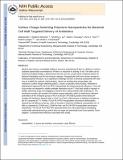Surface Charge-Switching Polymeric Nanoparticles for Bacterial Cell Wall-Targeted Delivery of Antibiotics
Author(s)
Radovic-Moreno, Aleksandar F.; Lu, Timothy K.; Puscasu, Vlad A.; Yoon, Christopher J.; Langer, Robert; Farokhzad, Omid C.; ... Show more Show less
DownloadLu_Surface change.pdf (840.1Kb)
OPEN_ACCESS_POLICY
Open Access Policy
Creative Commons Attribution-Noncommercial-Share Alike
Terms of use
Metadata
Show full item recordAbstract
Bacteria have shown a remarkable ability to overcome drug therapy if there is a failure to achieve sustained bactericidal concentration or if there is a reduction in activity in situ. The latter can be caused by localized acidity, a phenomenon that can occur as a result of the combined actions of bacterial metabolism and the host immune response. Nanoparticles (NP) have shown promise in treating bacterial infections, but a significant challenge has been to develop antibacterial NPs that may be suitable for systemic administration. Herein we develop drug-encapsulated, pH-responsive, surface charge-switching poly(d,l-lactic-co-glycolic acid)-b-poly(l-histidine)-b-poly(ethylene glycol) (PLGA-PLH-PEG) nanoparticles for treating bacterial infections. These NP drug carriers are designed to shield nontarget interactions at pH 7.4 but bind avidly to bacteria in acidity, delivering drugs and mitigating in part the loss of drug activity with declining pH. The mechanism involves pH-sensitive NP surface charge switching, which is achieved by selective protonation of the imidazole groups of PLH at low pH. NP binding studies demonstrate pH-sensitive NP binding to bacteria with a 3.5 ± 0.2- to 5.8 ± 0.1-fold increase in binding to bacteria at pH 6.0 compared to 7.4. Further, PLGA-PLH-PEG-encapsulated vancomycin demonstrates reduced loss of efficacy at low pH, with an increase in minimum inhibitory concentration of 1.3-fold as compared to 2.0-fold and 2.3-fold for free and PLGA-PEG-encapsulated vancomycin, respectively. The PLGA-PLH-PEG NPs described herein are a first step toward developing systemically administered drug carriers that can target and potentially treat Gram-positive, Gram-negative, or polymicrobial infections associated with acidity.
Date issued
2012-04Department
Harvard University--MIT Division of Health Sciences and Technology; Massachusetts Institute of Technology. Department of Chemical Engineering; Massachusetts Institute of Technology. Department of Electrical Engineering and Computer Science; Massachusetts Institute of Technology. Synthetic Biology CenterJournal
ACS Nano
Publisher
American Chemical Society (ACS)
Citation
Radovic-Moreno, Aleksandar F., Timothy K. Lu, Vlad A. Puscasu, Christopher J. Yoon, Robert Langer, and Omid C. Farokhzad. “Surface Charge-Switching Polymeric Nanoparticles for Bacterial Cell Wall-Targeted Delivery of Antibiotics.” ACS Nano 6, no. 5 (May 22, 2012): 4279–4287.
Version: Author's final manuscript
ISSN
1936-0851
1936-086X